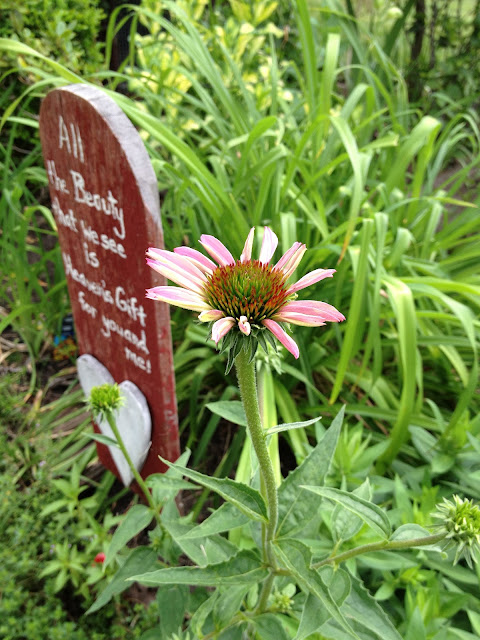 |
| Sunflowers....toasted. |
Last week, I picked up one of my season-by-season gardening
books and turned to the ‘Late Summer’ section. The first line says, in bold print, “The garden is at its
best now.” Whoa. Was this book written by a native
English speaker? Surely he
couldn’t understand what he was saying.
I’ve never lived through a late summer in which my garden was ‘at its
best’, but this year is the banner child for ‘Blech’.
My soft heart hasn’t helped the look of our garden one
bit. I’m a sucker for volunteer
plants, which are rather like cats: captivating in juvenile form, and rather
regrettable as adults. The birds
transferred some of my carefully selected SongBird Seed Mix to the front border
of our bed, where a smattering of 3-4’ sunflowers now reside. Had they been transplanted to the back
of the bed in a timely manner, they might’ve looked halfway decent, but a
little procrastination left them right where they were sown. With browning leaves and drooping
heads, they are now well past their glory days. The meticulous gardener would remove them, but not I. No, the cardinals and finches are still
working on the seed heads, and I love getting double the return on my SongBird
Seed Mix. I paid extra, after all.
 |
| Getting double the pleasure from a bag of birdseed. |
My weakness for volunteers is especially susceptible in the tomato department. I have several sprouting
in and around the compost pile. One particularly enormous specimen has overtaken my back steps. That soft heart of mine is touched by their tale of bravery, a hypothetically epic story of bitter cold winter nights, greedy birds looking for an easy meal, and parched July afternoons. Who am I to quash their chance at life? Additionally, I cling to the hope that one volunteer might reward me with an incredible new tomato variety and a million dollar plant patent, or just really amazing salsa.
 The monstrous tomato swallowing up my back steps is not that
plant. The tomatoes are mediocre
at best, and still I’ve accommodated its zest for life. My reward? A steadily shrinking stairway. It is now less than a foot wide, and I’m not talking about
the 12 inch foot. I’m talking one
Nike wide. It’s getting ridiculous
over here. Soft heart be danged,
I’m going to get the pruners. Next
year, I’ll be a tough old biddy on those volunteers. I’ve learned my lesson. Yeah, right.
The monstrous tomato swallowing up my back steps is not that
plant. The tomatoes are mediocre
at best, and still I’ve accommodated its zest for life. My reward? A steadily shrinking stairway. It is now less than a foot wide, and I’m not talking about
the 12 inch foot. I’m talking one
Nike wide. It’s getting ridiculous
over here. Soft heart be danged,
I’m going to get the pruners. Next
year, I’ll be a tough old biddy on those volunteers. I’ve learned my lesson. Yeah, right.
I’ve half a mind to retire this column on the simple basis
that a visual overview of my property raises serious inquiries as to my
qualifications to be doling out any sort of gardening advice, be it ever so
humble. The other half of my mind confirms
that it’s time I return to the ultimate path to riches: substitute
teaching. So it is with a fond
farewell that I bid you adieu. I
will miss our little chats. Tall, Dark, and Handsome is going to have to up his
conversational skills.








































